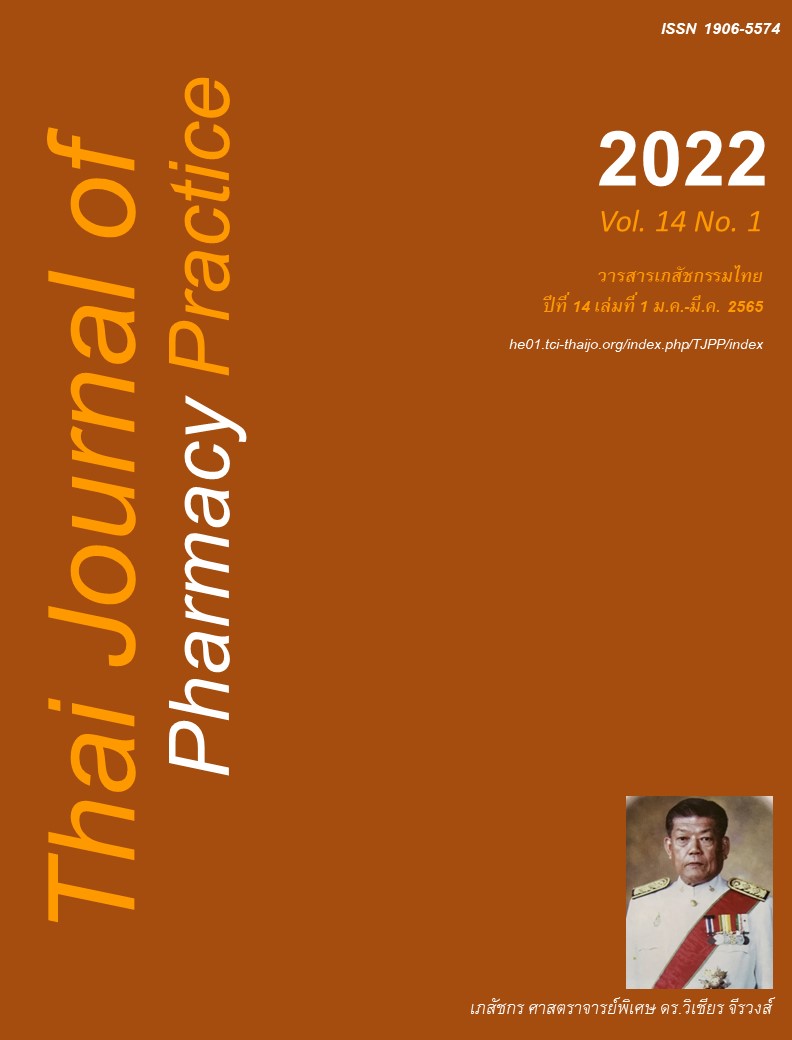ประสิทธิภาพของยา finasteride รูปแบบยาทาเฉพาะที่ในผู้ที่มีโรคผมบางแบบพันธุกรรม
Main Article Content
บทคัดย่อ
เส้นผมที่งอกปกคลุมหนังศีรษะของมนุษย์ถือเป็นส่วนหนึ่งของชั้นหนังกำพร้า ตามธรรมชาติเส้นผมจะมีการหลุดร่วงและงอกใหม่อยู่เสมอ กระบวนการหลุดร่วงและงอกใหม่ของเส้นผมมักมีหลากหลายปัจจัยที่เกี่ยวข้อง เช่น ปริมาณสารอาหาร พันธุกรรม เป็นต้น ปัญหาผมร่วงและผมบางอย่างฉับพลันที่พบได้บ่อยทั้งในเพศชายและเพศหญิง มักมีสาเหตุจากพันธุกรรมหรือเรียกว่าโรคผมบางแบบพันธุกรรม (androgenetic alopecia) ภาวะผมร่วงและผมบางชนิดนี้เกิดจากพันธุกรรมและฮอร์โมนแอนโดรเจน แนวทางการรักษาผมร่วงและผมบางในปัจจุบันมีทั้งการใช้ยา หวีเลเซอร์ รวมไปถึงการปลูกถ่ายเส้นผม บทความนี้มุ่งเน้นที่การรักษาด้วยยาเป็นหลัก ยาแผนปัจจุบันที่ได้รับการรับรองจากสำนักงานคณะกรรมการอาหารและยาของสหรัฐอเมริกาในการรักษาผมบางแบบพันธุกรรม ได้แก่ ยา finasteride ชนิดรับประทานและยาทาเฉพาะที่ minoxidil เนื่องจากยา finasteride ชนิดรับประทานมีผลข้างเคียงค่อนข้างมาก เช่น เวียนศีรษะ ความผิดปกติของการแข็งตัวของอวัยวะเพศ เป็นต้น จึงมีการศึกษาการใช้ยา finasteride รูปแบบยาทาเฉพาะที่ซึ่งมีหลายการศึกษาที่พบว่า การใช้ยา finasteride รูปแบบยาทาเฉพาะที่ช่วยรักษาผมบางผมร่วงได้ และสามารถลดผลข้างเคียงจากการใช้ยา finasteride รูปแบบยารับประทานลงได้
Article Details
ผลการวิจัยและความคิดเห็นที่ปรากฏในบทความถือเป็นความคิดเห็นและอยู่ในความรับผิดชอบของผู้นิพนธ์ มิใช่ความเห็นหรือความรับผิดชอบของกองบรรณาธิการ หรือคณะเภสัชศาสตร์ มหาวิทยาลัยสงขลานครินทร์ ทั้งนี้ไม่รวมความผิดพลาดอันเกิดจากการพิมพ์ บทความที่ได้รับการเผยแพร่โดยวารสารเภสัชกรรมไทยถือเป็นสิทธิ์ของวารสารฯ
เอกสารอ้างอิง
Schlake T. Determination of hair structure and shape. Semi Cell Dev Biol 2007; 18: 267-73.
Wolfram LJ. Human hair: a unique physicochemical composite. J Am Acad Dermatol 2003; 48: S106–114.
Thaichinda S. Alopecia. Songkla Med J 2008; 26: 587-99.
Buffoli B, Rinaldi F, Labanca M, Sorbellini E, Trink A, Guanziroli E et al. The human hair: from anatomy to physiology. Int J Dermatol 2014, 53: 331–41.
Jaruwijitratana S. Patient with alopecia [online]. date unknown [cited Feb 9, 2021]. Available from: med.mahidol.ac.th/med/sites/default/files/public/pdf/medicinebook1/Ptn-Alopecia.pdf.
Suwajo P, Pungrasmi P, Panchaprateep R, Haetanurak S. Hair transplantation. Chula Med J 2017; 61: 51 – 71.
Bernardez C, Molina-Ruiz AM, Requena L. Histologic features of alopecias-part I: nonscarring alopecias. Actas Dermosifiliogr 2015; 106 :158–67.
Dhariwala MY, Ravikumar P. An overview of herbal alternatives in androgenetic alopecia. J Cosmet Dermatol. 2019; 18: 966-75.
Lolli F, Pallotti F, Rossi A, Fortuna MC, Caro G, Lenzi A, Sansone A, Lombardo F. Androgenetic alopecia: a review. Endocrine. 2017; 57: 9-17.
Feinstein RP. Androgenetic alopecia treatment & management [online]. date unknown [cited Feb 11, 2021]. Available from: emedicine.medscape.com/ article/1070167-treatment.
Rossi A, Cantisani C, Melis L, Iorio A, Scali E, Calvieri S. Minoxidil use in dermatology, side effects and recent patents. Recent Pat Inflamm Allergy Drug Discov. 2012; 6:130–6.
Mella JM, Perret MC, Manzotti M, Catalano HN, Guyatt G. Efficacy and safety of finasteride therapy for androgenetic alopecia: a systematic review. Arch Dermatol. 2010; 146: 1141-50.
Lee WS, Lee HJ, Choi GS, Cheong WK, Chow SK, Gabriel MT, et al. Guidelines for management of androgenetic alopecia based on BASP classifi cation–the Asian consensus committee guideline. J Eur Acad Dermatol Venereol 2013; 27: 1026–34.
Varothai S, Bergfeld WF. Androgenetic alopecia: an evidence-based treatment update. Am J Clin Dermatol 2014; 15: 217-30.
Zito PM, Bistas KG, Syed K. Finasteride [online]. 2020 [cited Feb 11, 2021]. Available from: www.ncbi.nlm.nih.gov/books/NBK513329/.
Finasteride. In: Micromedex® Healthcare Series [database on the Internet]. Greenwood Village, Colorado: Thomson Micromedex; 2020 [cited Feb 2, 2021]. Available form: www.thomsonhc.com. Subscription required to view
Khan MZU, Khan SA, Ubaid M, Shah A, Kousar R, Murtaza G. Finasteride topical delivery systems for androgenetic alopecia. Curr Drug Deliv. 2018; 15:1100–1.
Mazzarella GF, Loconsole GF, Cammisa GA, Mastrolonardo GM, Vena G. Topical finasteride in the treatment of androgenic alopecia. Preliminary evaluations after a 16-month therapy course. J of Derm Tr. 1997; 8: 189–92.
Hajheydari Z, Akbari J, Saeedi M, Shokoohi L. Comparing the therapeutic effects of finasteride gel and tablet in treatment of the androgenetic alopecia. Indian J Dermatol Venereol Leprol. 2009; 75: 47-51.
Caserini M, Radicioni M, Leuratti C, Terragni E, Iorizzo M, Palmieri R. A novel finasteride 0.25% topical solution for androgenetic alopecia: pharmacokinetics and effects on plasma androgen levels in healthy male volunteers. Int J Clin Pharmacol Ther. 2014; 52: 842-9.
Caserini M, Radicioni M, Leuratti C, Terragni E, Iorizzo M, Palmieri R. Effects of a novel finasteride 0.25% topical solution on scalp and serum dihydrotestosterone in healthy men with androgenetic alopecia. Int J Clin Pharmacol Ther. 2016; 54: 19-27.
Tanglertsampan C Efficacy and safety of 3% minoxidil versus combined 3% minoxidil/0.1% finasteride in male pattern hair loss: a randomized, double-blind, comparative study. J Med Assoc Thai. 2012; 95: 1312–6.
Pharmacy Department, Siriraj hospital. Siriraj drug list [online] 2020. [cited 2021 Apr 17]. Available form: pis.si/sipharmmaster/druglist/dl_login.aspx.
Wichayapreecha P, Yingngam N, Charoenthai N, Rungseevijitprapa W. Development of finasteride proniosomes for transfollicular delivery. In: Anon, eds. Meeting at pharmacy profession: Moving forward to ASEAN harmonization: Proceedings of the 5th Annual Northeast Pharmacy Research Conference. 2013, Feb 16-17; Khon Kaen, Thailand; 2013. p.180-5.


